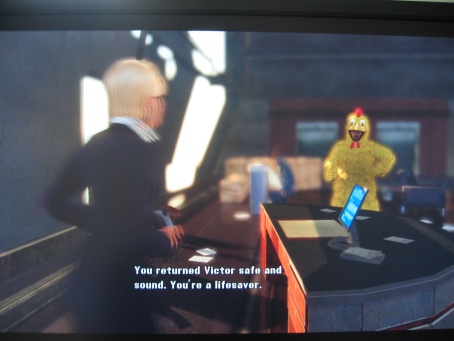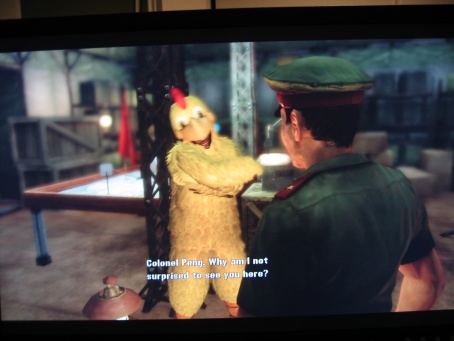Ummm… hello again.
It’s with my tail firmly wedged between my legs that I return to the game-blogging world; after another massive Fringe (131 “official” shows, another handful of impromptu gigs, and nowhere near enough writing done… I’ve still got 93 shows left to write about!), there was a long period where I couldn’t face the keyboard at all. Which is proving to be a bit of a problem with work, but that’s another story.
That’s not to say that I’ve forgotten about gaming; quite the opposite. In recent years I had experienced a kind of post-Fringe malaise, a separation-anxiety after the hyper-social frivolities of my ultra-arty-month; but that didn’t really seem to be the case this year, and I hurled myself back into gaming with a vengeance. This seemed to be fuelled by the games that were released during my self-enforced gaming exile: Double Fine‘s Stacking was the first cab off the rank, followed closely by Beyond Good & Evil HD.
Double Fine games are an easy sell to me; I love Tim Schafer‘s work. Costume Quest proved that, even with his role reduced to that of an overseeing producer, the rest of the company has more than enough talent to pump out funny and focused games. Stacking proved to be a perfect sibling for Costume Quest – a short, punchy game with a distinct sense of individuality and style, backed up with an elegant sense of humour. A short late-night taster of the game turned into a six-hour session, experimenting with all the different dolls and their special abilities (the flatulent efforts managing to bring an immature smile to my face, whilst managing to somehow remain charming). It didn’t take long to explore the breadth of the game, but there was a short wait until the Lost Hobo King DLC was released in early April, and then it was crossed off The List.
The second of the March releases was Beyond Good & Evil HD. Despite having heard many raves about this game, I knew next to nothing about it – but its age was apparent from the somewhat clumsy opening. It’s a great game, though, and I managed to hammer through a pair of playthroughs in quick time before crossing that one off The List too.
So – with two new purchases quickly wrapped up, I cast my mind back to my Gaming Resolutions for 2011, and decided to tackle a game from one of the previous generations; the Chosen One was Deus Ex: Invisible War (hereafter more conveniently referred to as DX2) on the original Xbox. I adore the original Deus Ex for its wide scope and political intrigue, coupled with a solid FPS with RPG aspects and myriad possibilities. And I recall being ultra-keen on this game when I first saw the leaked opening FMV back in early 2004. And I also remember the disappointment when I first played the game, blasting through it on the easiest difficulty setting in a couple of days… before turning my back on it. A neutered ammo system, the removal of the RPG elements, and an overwhelming feeling of claustrophobic simplification all combined to leave a distasteful memory.
Hence, I returned to the game with trepidation, wary of the experience my memories recalled. And first (re-)impressions were not good; time has not been good to DX2‘s visuals, with dim and grimy textures on the tiny maps and an appalling frame-rate. But, pushing on through a playthrough on Normal (the second of four difficulty levels), I was soon immersed in a storyline that – whilst failing to even approach the sophistication of the original – was still quite satisfying. Tinkering around with biomods encouraged me to tackle levels in a creative manner, yielding enjoyable solutions where my first playthrough had been brute-force and tedious. Indeed, I found myself having fun with this much-maligned game.
I eventually reached the final “level” – a return to the opening location of the first game, where decisions can be made to yield any of the game’s four endings. But the visuals had taken their toll, and I needed a high-definition break… and, wandering through JB Hifi to find a present for my nephew’s birthday, I discovered the perfect antidote: Just Cause 2, which had languished on my “To Buy” List since its release nearly a year ago. A 20%-off sale, a sticker-price on a brand new copy for less than AU$40… sold.
At first, I was a bit perturbed by some of the voice work in Just Cause 2 – Sheldon’s voice actor is the same guy who played the porcine Pey’j in Beyond Good & Evil. Hearing them (almost) back-to-back in two very different character roles was… well, odd. But everything I wrote about the first Just Cause still holds true in the sequel – there’s a massive brand-new open world (the gorgeous island paradise of Panau) to explore, but it’s still filled with cookie-cutter missions that became almost mechanically rote to conquer. The sequel is significantly more polished than the original (aside from some gameplay tweaks that I feel are detrimental), but there’s one are in which it absolutely shines: the numbers game.
I’ve said before that I love a good grind, and Just Cause 2 offers the opportunity to grind oneself raw. 368 369 smaller missions, 75 races, over 5000 (yes – five thousand) collectibles & destructibles, each and every one of them responsible for a little OCD endorphin rush… this is a game that takes ages to complete to satisfaction, even if it’s impossible to 100%. And, sure enough, 120 hours on my Casual playthrough yielded a maximum of 99.95%; my Hardcore playthrough, a more efficient 100 hours, also yielded a 99.95% final statistic – and a plethora of bugs, which I’ll whinge about at a later stage.
I’ve also indulged in a little twin stick shooting – Geometry Wars, Geometry Wars^2, a little bit of Robotron, and a splash of Mutant Storm Reloaded. And I’m still shit at all of them. I returned and finished off my Normal playthrough of DX2 – all four five endings, tiptoeing around the final level before letting loose with barely controlled use of the rocket launcher. There’s another two playthroughs required on that one, though – but, to be honest, I really enjoyed the time I spent with this sequel. It revived interest in the upcoming Deus Ex: Human Revolution, though dissenting opinions about the most recent build of that have dampened my enthusiasm somewhat.
You might have noticed that there was a minor disturbance in the gaming world a few months back when Sony’s PSN account databases were compromised. Now, I’ve frequently been critical of PSN in the past, and I remember heaving a sigh of relief when I realised I’d never entered my credit card details into the system. But the leaked (alleged) details about the naïveté of PSN’s infrastructure certainly gave reason to roll one’s eyes in disgust; plain text passwords, really? Sure, even I’ve done that before – but that was my first project out of Uni (and it certainly wasn’t exposed to the Internet), and I soon learnt pretty quickly why it’s a ferociously dumb idea.
But Sony’s “Welcome Back” package, while a blatant attempt to placate the (rightfully) angry public, was certainly welcome to me – despite my wariness of free games. Still, I picked up inFAMOUS and the (perennially List-bound) WipEout HD, and managed to knock out a quick Platinum trophy on the former. It’s fair to say, now, that the PS3 is beginning to earn its keep in The Moobaarn – the grand total of AU$75 I’ve spent on the system and games so far has just broken into positive value-for-money territory.
The final game I’ll mention in this little roundup of the last five(!) months is a game that both inspired great excitement as well as great trepidation: Child of Eden. I’ve ham-fistedly tried to explain how much I love Rez, but I cannot honestly say that I ever wished for a sequel, or even more content; Rez (and especially Rez HD) is perfect in just about every way. But Miz reckons that Child of Eden is a spiritual successor to Rez, so (despite its release in the middle of the Adelaide Cabaret Festival) it was a day-one purchase.
But, after several attempts to get into the groove, I’m really not feeling it at the moment.
Maybe it’s the twee overtones of the (incredibly polished) production. Maybe it’s the lack of coherency of the visuals. Maybe it’s the lack of the player avatar onscreen (understandably necessary because of the Kinect integration, but its absence is noticeable for those of use wielding traditional controllers). Maybe it’s the fact that the controls don’t feel as familiar to me as I’d like. Maybe it’s the lack of connection with the music; there’s nothing as immediately uplifting as Rez‘s Area 1 tune (Buggie Running Beeps) or Area 4’s pulse-thumping Rock Is Sponge. Or maybe it’s the fact that I’m finding it a little bit difficult.
But I remember that Rez took a while for me to “learn”, too – I certainly recall struggling to finish Area 4 at all, and needing oodles of practise before finally conquering Area 5 – both of which I can breeze through now after a night out at the pub. But the difference is that I was immediately drawn into the world of Rez; I wanted to be there. It feels like Child of Eden is holding me at arms length – a cold pat on the shoulder, when what I really want is a warm hug. Still, I’ll persevere – after all, that’s my lot in life – and maybe I’ll learn to love it… I certainly hope I’ll learn to love it.
And, after five months away, that pretty much brings us up to date. Sorry about this mish-mash of text, but there were words on my fingertips that needed to get out – hopefully there’ll be a few more coherent pieces coming soon. In the meantime, though, there’s more DX2, and more Child of Eden…

